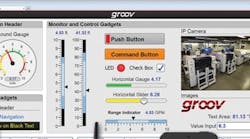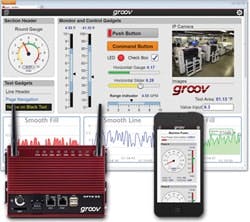Jim Montague is the executive editor for Control. Email him at [email protected].
Software, PCs and the Internet revolutionized control and automation and the industries they serve. However, it still takes plenty of programming and configuration to build HMIs, set up SCADA systems, commission servers and perform web-based monitoring, troubleshooting and control. Organizing the plug-ins and formatting required to provide monitoring and control on multi-sized displays from big control room screens to tablet PCs and smartphones makes this even harder.
To help users overcome these hurdles, Opto 22 developed its groov platform for building simple, web-based interfaces to monitor and control equipment using computers and mobile devices. Using only a web browser, groov lets users build and deploy web-based automation, monitoring and control applications for Opto 22 components, and display their data and interact with them on almost any computer or mobile device, regardless of its operating system.
"We've all seen the power and capabilities of smartphones and tablets, but it's still difficult for them to put real web-based control into users' hands on the plant floor," says Benson Hougland, Opto 22's vice president of marketing and product development. "It's a nice idea to build a mobile-ready, web-based, server-centered monitoring and control application. I tried it myself a few years ago, but I had to call in a web developer and an IT professional to help. With groov, we've put the pieces together, and one person using nothing more than a web browser can create displays that can be viewed on any PC, tablet or smartphone."
To get up and running, users only need to know how to plug in an Ethernet cable, use a keyboard, mouse and browser, and what they want to view. Hougland says users just log in with a browser, point to the controller's tag database, drag and drop software gadgets on a page, and save the project. Then, any authorized mobile device or computer with a modern web browser can log in.
Hougland and Opto 22's engineers refer to groov as a "human-device interface" (HDI) because it augments regular HMIs by allowing them to easily display data on smartphones and other mobile devices. Also, groov and its displays are based on HMI best practices, as described in The High Performance HMI Handbook.
The platform's primary parts include:
- groov Box — an industrially hardened appliance with two Gigabit Ethernet ports and one 802.11n wireless port that interface with Opto 22's controls and run the groov web application. It contains embedded microprocessors and an SQL database.
- groov Build — the web application's mode for creating an interface project. This editing suite, which works within the browser, includes buttons, gauges, indicators and other interface devices that can be linked to actual data tags and points; and gadgets for displaying video streams and images.
- groov View — the web application's mode to run a groov project in any modern web browser.
- groov View for iOS — an optional iOS app.
- groov View for Android.
Groov was itself built using standard HTML 5 and Scalable Vector Graphics (SVG), so it doesn't require software plug-ins such as Java, Flash and Silverlight to translate between different-sized display formats. Likewise, SVG allows sweeping and other touchscreen devices and functions to be scaled up and down just as easily.
Because its own software, hardware and networking are separate from the controls it monitors, groov is inherently secure, Hougland says. "It further improves its security by using the web-based Secure Socket Layer (SSL) protocol and 128-bit encryption to protect data moving on its network and prevent other entities from viewing it."
Initial release of groov is planned for March.






